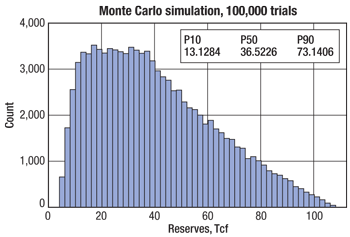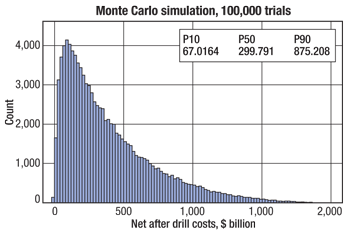What’s new in exploration
Rolling the dice in the shale plays
Rolling the dice in the shale plays Shale gas is constantly in the news these days, and the flow of analyses on US shale gas offers a strikingly wide range of reserve estimates and uncertainty in those estimates. Like so many prediction methods, reserve estimations become tighter, more reliable, as ground truth is added to the analysis. We expect that, with additional drilling results, seismic and production data, the reserve estimate for, say, a single gas field will become more accurate over time. But at the level of shale gas plays, we find ourselves in vast areas and in the very early days of drilling and production. So how can we possibly come up with reserve estimates? There are two fundamentally different ways. The first approach, “bottom up,” involves estimating the areal extent of gas-rich shale, along with thickness, porosity, water saturation, recovery factor and more. The second approach, “top down,” cares little for geological details, being more interested in how many wells are likely to be drilled, at what cost, and the per-well EUR. We will look at the second method, because it naturally leads to a computation method used broadly in science, technology and finance. Let’s use the Haynesville Shale play as our example. Shale plays are driven by energetic, growing companies. The information we need won’t be in dusty academic journals, but rather in the latest presentation for potential investors. Go to your favorite company’s website and look up “investor relations.” You will find a mountain of information, especially by studying several companies. To get started, we need to know how many total wells are likely to be drilled in the Haynesville. Based on published maps, the 200-ft thickness contour seems to appropriately outline the play. This area is about 4,300 sq mi, and company information indicates average well spacing of 100 acres. Allowing for spacing inefficiency (one-third of potential sites), we estimate 9,000 total wells. As of mid-2010, about 860 have been drilled. The EUR/well is generally estimated at 4–12 Bcf, although this is projected from, at most, two years of production (the discovery well was drilled in March 2008). So how do we make a reserve estimate? First, guess a total well count between 1,000 and 9,000 and an EUR/well between 4 and 12 Bcf. If we guess 4,200 wells with an average EUR of 7 Bcf, the reserve estimate would be the product of these two numbers, or 29.4 Tcf. It may happen that this result is correct (lucky us!), but that is highly unlikely. In the real world only one future will play out. But in the computer we can test all reasonable scenarios, and results that occur many times are more likely to happen in the real world. This is called Monte Carlo simulation (MCS). It works like this. We repeat the procedure described above many times, using a random number generator in each calculation to guess the number of wells and EUR/well, while honoring the limits on those quantities. Do this, say, 100,000 times, and you get a histogram, Fig. 1.
We pull off the standard P10, P50 and P90 probabilities, and find that 10% of the scenarios (P10) have reserves less than 13 Tcf, a long-shot bet on the low end. Equally far-fetched on the high end, P90 tells us that 10% of the outcomes yield reserves above 73 Tcf. To get this result in the real world, both the number of wells drilled and EUR/well would have to be near the upper limits. The most likely result, P50, is 36 Tcf. Note, however, that this histogram has a plateau between 12 and 36 Tcf, meaning these outcomes are almost equally likely. The powerful thing about MCS is how easily it extends to problems of daunting complexity. For example, you might want to estimate the money side of things rather than reserves, requiring ranges in well cost and gas price. Haynesville wells are deep, high-tech horizontals that cost $6–12 million each. As we are all painfully aware, the US gas price is highly variable. Let’s assume that over the life of the play (2008–2030?) the average will be in the range of $2–$20/Mcf. Now the procedure goes like this: Guess 1) a number of wells, 2) an EUR/well, 3) a well cost and 4) a gas price. Now repeat 100,000 times to get a histogram for the dollar value of the Haynesville Shale gas play net after drill costs, Fig. 2. P50 tells us the Haynesville is likely a $300 billion play. A curious feature of this plot is that some cases give a negative value. Is this possible? Sure, all we need is for gas prices to collapse and drilling costs to skyrocket. But then who would drill the 9,000 wells to realize this future?
Of course, once we are talking about money a lot of complexity creeps in: cash flow, royalties, tax burden, rate-of-return targets, and so on. But with a little free time, I think someone could work that into a nice Monte Carlo simulation.
|
||||||||||||||||
- Prices and governmental policies combine to stymie Canadian upstream growth (February 2024)
- U.S. producing gas wells increase despite low prices (February 2024)
- U.S. drilling: More of the same expected (February 2024)
- U.S. oil and natural gas production hits record highs (February 2024)
- Quantum computing and subsurface prediction (January 2024)
- U.S. upstream muddles along, with an eye toward 2024 (September 2023)
- Applying ultra-deep LWD resistivity technology successfully in a SAGD operation (May 2019)
- Adoption of wireless intelligent completions advances (May 2019)
- Majors double down as takeaway crunch eases (April 2019)
- What’s new in well logging and formation evaluation (April 2019)
- Qualification of a 20,000-psi subsea BOP: A collaborative approach (February 2019)
- ConocoPhillips’ Greg Leveille sees rapid trajectory of technical advancement continuing (February 2019)






